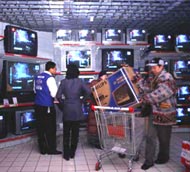 China’s market has since 1997 been transformed from a seller’s market to a buyer’s market in which consumers can buy almost whatever they need. But there are problems: Goods aimed at urban buyers are in oversupply while China’s some 800 million rural people long for low-end products in short supply. Staple goods are widely available but not sophisticated and high-end products. Too much is being invested in the traditional sectors but not enough to key and start-up sectors. Some industrial sectors are producing too much while the agriculture and service sectors are producing too little.
China’s market has since 1997 been transformed from a seller’s market to a buyer’s market in which consumers can buy almost whatever they need. But there are problems: Goods aimed at urban buyers are in oversupply while China’s some 800 million rural people long for low-end products in short supply. Staple goods are widely available but not sophisticated and high-end products. Too much is being invested in the traditional sectors but not enough to key and start-up sectors. Some industrial sectors are producing too much while the agriculture and service sectors are producing too little.
Qiu Xiaohua, deputy director of National Bureau of Statistics offered his view on the situation:
“It appears that many products are in over-supply. But actually an invisible shortage exists, a shortage for products that can stimulate consumers’ demand,” Qiu Xiaohua said.
Take refrigerators and television sets as an example, Qiu said.
“Overproduction of refrigerators and TVs has driven manufacturers into a suicidal price war. I think they should shift their focus away from cities, where most people already own these products, to rural areas where there is a real demand,” Qiu said.
Manufactures have been designing refrigerators and TVs for city buyers only to find their goods excessive in a city market and unpopular in a rural market. Rural people want inexpensive low-end electronic appliances that are simple and last long. In the 800 million peasants’ market, a shortage exists in the midst of over-supply. Manufacturers need to design kinds of products for different kinds of markets. Only in this way can we eliminate the strange phenomena of “invisible shortage in overproduction.”
Qiu also think correcting the “invisible shortage” problem would offer an important step to optimizing the supply chain.
Some small outmoded enterprises and monopolies, especially administrative monopolies from government departments that produce inefficient or even useless products, need to be weeded out to improve their sector’s supply structure. Traditional industries should update products while start-up industries need to see increased investment.
Manufacturers should, through technological innovation, bring out new products, improve products quality and cut down costs to stimulate potential consumer demand.
(China.org.cn 08/15/2001)
